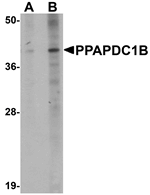
WB analysis of EL4 cell lysate using GTX85223 PPAPDC1B antibody. Working concentration : (A) 1 and (B) 2 microg/ml
PPAPDC1B antibody
GTX85223
Overview
- SupplierGeneTex
- Product NamePPAPDC1B antibody
- Delivery Days Customer9
- Application Supplier NoteWB: 1 - 2 microg/mL. *Optimal dilutions/concentrations should be determined by the researcher.Not tested in other applications.
- ApplicationsWestern Blot, ELISA
- CertificationResearch Use Only
- ClonalityPolyclonal
- Concentration1 mg/ml
- ConjugateUnconjugated
- Gene ID84513
- Target namePLPP5
- Target descriptionphospholipid phosphatase 5
- Target synonymsdiacylglycerol pyrophosphate like 1; diacylglycerol pyrophosphate phosphatase-like 1; DPPL1; HTPAP; phosphatidate phosphatase PPAPDC1B; phosphatidic acid phosphatase type 2 domain containing 1B; phosphatidic acid phosphatase type 2 domain-containing protein 1B; phospholipid phosphatase 5; PPAPDC1B; testicular secretory protein Li 38
- HostRabbit
- IsotypeIgG
- Protein IDQ8NEB5
- Protein NamePhospholipid phosphatase 5
- Scientific DescriptionPhosphatidate phosphatase (PAP) plays important role in lipid-signaling metabolism in eukaryotic cells. Two distinct types of PAP (PAP1 and PAP2) activity have been distinguished by their subcellular localization and differential sensitivity to N-ethylmaleimide (NEM) and Mg2+. A yeast diacylglycerol pyrophosphate (DGPP) phosphatase (DPP1) and mammalian DGPP phosphatase (PAP2) have been identified as Mg2+-independent and NEM-insensitive membrane-associated. PPAPDC1A (also known as DPPL2) and PPAPDC1B (DPPL1) form a novel type of Mg2+-independent and NEM-sensitive mammalian phosphatidate phosphatase showing broad substrate specificity. Knockdown experiments indicated that this protein is involved with multiple cell signaling pathways, including the JAK-Stat3, MAP kinase, and PKC pathways. PPAPDC1B may also potentiate the estrogen receptor pathway by down-regulating DUSP22.
- Storage Instruction-20°C or -80°C,2°C to 8°C
- UNSPSC12352203





